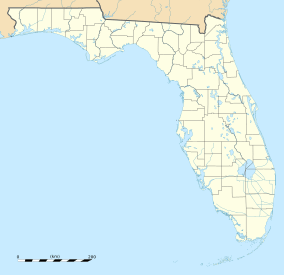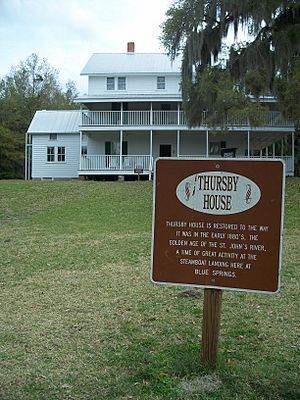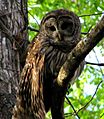Blue Spring State Park facts for kids
Quick facts for kids Blue Spring State Park |
|
|---|---|
|
IUCN Category III (Natural Monument)
|
|
| Location | Volusia County, Florida, United States |
| Nearest city | Orange City, Florida |
| Governing body | Florida Department of Environmental Protection |
Blue Spring State Park is a cool place to visit in Florida, near Orange City, Florida. It's a popular spot for fun activities like canoeing, SCUBA diving, kayaking, fishing, camping, hiking, watching animals, and swimming. The main attraction is Volusia Blue Spring, the biggest spring connected to the St. Johns River. Because its water stays warm (about 73°F or 23°C), lots of Florida manatees come here in winter. Every day, about 102 million gallons of water flow from Blue Spring into the St. Johns River!
Contents
Discovering Blue Spring: A Look at Its Past
The Blue Spring area has a long and interesting history.
Early Explorers and Settlers
The spring was first visited by a botanist named John Bartram way back in 1766. Later, in the mid-1800s, the Weismore family bought the spring and the land around it. They built a large house, like a plantation home, on a shell mound nearby.
Citrus Groves and Tourism
The area was great for growing citrus fruits, like oranges. A small railway was even built to connect Orange City to the dock at Blue Spring. But in the 1890s, a really bad freeze happened. It destroyed all the citrus farms, and the industry moved further south.
After that, the Thursby family, who owned the land, started focusing on tourism. People loved visiting the beautiful spring and enjoyed fishing and hunting along the St. Johns River.
Protecting Manatees
In 1972, the Florida Department of Environmental Protection bought the park. They did this to start a special program to protect manatees, which are very important to Florida's wildlife.
Manatee Research: Learning About These Gentle Giants
Scientists have been studying individual manatees at Blue Spring since 1978. They record important details like births, deaths, and how manatees are related.
Why Manatees Come Here
Manatees travel to warmer spring waters when Florida's weather gets cold. They often return to the same spring every year.
How Scientists Identify Manatees
Scientists can tell manatees apart by their unique scar patterns. Most of these scars come from boats hitting them. But they can also get scars from fishing lines, cold weather, or skin infections.
A Huge Database of Manatees
The information collected at Blue Spring, both in person and through live video, is part of one of the world's oldest and most complete manatee databases. Different government groups work together to keep up this Manatee Individual Photo-Identification System for Florida manatees. Park rangers and researchers from the Save the Manatee Club at Blue Spring have added many manatee sightings to this important database.
Keeping Blue Spring Healthy: Environmental Challenges
Blue Spring faces some environmental challenges.
Water Quality Concerns
More and more people visit the park, and the number of manatees has also grown. This puts a strain on the spring's natural environment. Both humans and manatees can cause water pollution. This leads to more stringy algae growing in the spring.
Water Supply Issues
Another problem is that the natural water supply to the spring is decreasing. This is because nearby cities are pumping a lot of groundwater. As a result, the amount of water flowing out of Volusia Blue Spring has gone down over the past few decades.
Fun Things to Do at Blue Spring State Park
Blue Spring State Park offers many ways to enjoy nature and have fun.
Camping and Cabins
The park has 51 campsites and six cabins you can rent. The camping area is also friendly for pets.
Exploring the Spring and River
The spring run is a few miles long. There's a boardwalk that stretches about a third of a mile from the St. Johns River to the main spring.
Water Activities
During manatee season (from mid-November to March), you can't do any water activities in the spring to protect the manatees. But at other times, qualified SCUBA divers can explore the spring cave. You can also go canoeing, kayaking, and fishing.
Other Park Features
- Picnicking: Many picnic tables are scattered around the park, and there are pavilions for groups.
- Sports and Play: The park has volleyball courts and a playground.
- History: The old Thursby plantation house is still there. It has historical displays you can explore.
- Wildlife Watching: Besides manatees, you might see alligators, bears, raccoons, and many kinds of birds.
- Nearby Parks: Hontoon Island State Park is just a short paddle down the St. Johns River.
- Amenities: You can find food, stores, and a place to rent water activity gear.
Images for kids
-
A barred owl near Blue Spring.
-
Limpkin on the St. Johns River
-
Wood stork near Blue Spring
-
Red-shouldered hawk, Florida subspecies
-
Wood stork on the St. Johns near Blue Spring
-
An alligator on the St. Johns River
-
Turkey vulture near the lagoon
-
Florida scrub jay in the campground
-
Wood storks on the Smith Canal near Blue Spring



















